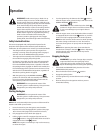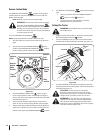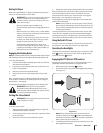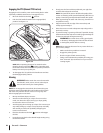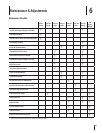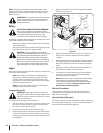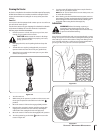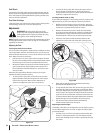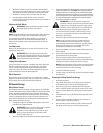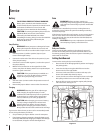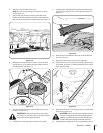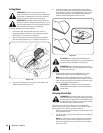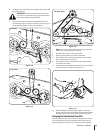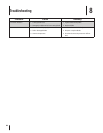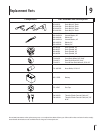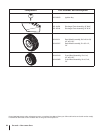
25Section 6 — Maintenance & adjuStMentS
2. Measure the distance from the outside of the left blade
tip to the ground and the distance from the outside of the
right blade tip to the ground. Both measurements taken
should be 4”. If they’re not, proceed to the next step.
3. Using the right and left lift rods, raise or lower the
necessary side of the deck until both sides are measured at
4” from the pavement.
Adjusting the Deck Wheels
WARNING!: Keep hands and feet away from the
discharge opening of the cutting deck.
NOTE: The deck wheels are an anti-scalp feature of the deck and
are not designed to support the weight of the cutting deck.
The deck wheels should be approximately ⁄⁄” above the
ground when the deck is set in the desired height setting. To
adjust the deck wheels see the Assembly & Set-Up section for
instructions.
Seat Adjustment
Refer to the Assembly & Set-Up section of this manual for seat
adjustment instructions.
WARNING! Before operating the tractor, make
sure the seat is engaged in the seat-stop. Engage the
parking brake. Stand behind the machine and pull
back on seat until it clicks into place.
Parking Brake Adjustment
If the tractor does not come to a complete stop when the brake
pedal is completely depressed, or if the tractor’s rear wheels
can roll with the parking brake applied (and the hydrostatic
relief valve open), the brake is in need of adjustment. See your
authorized dealer to have the brake adjusted.
Wheel Alignment
If your tractor pulls to one side or is out of alignment, a wheel
alignment might be necessary. Take your tractor to an authorized
service dealer to have the wheels properly aligned.
Off-Season Storage
Riding Mower Storage
If your riding mower is not going to be operated for an extended
period of time (thirty days to approximately six months), the riding
mower should be prepared for storage. Store the riding mower
in a dry and protected location. If stored outside, cover the riding
mower (including the tires) to protect it from the elements. The
procedures outlined below should be performed whenever the
riding mower is placed in storage.
1. Change the engine oil and filter following the instructions
provided in the Engine Manual.
WARNING! Never store the riding mower with fuel
in the tank indoors or in poorly ventilated
enclosures, where fuel fumes may reach an open
flame, spark or pilot light as on a furnace, water
heater, clothes dryer, etc.
2. Service the engine as instructed in the separate engine manual.
3. Engines stored between 30 and 90 days need to be treated with
a gasoline stabilizer such as STA-BIL® and engines stored over
90 days need to be run empty of fuel to prevent deterioration
and gum from forming in fuel system or on essential carburetor
parts. If the gasoline in your engine deteriorates during storage,
you may need to have the carburetor, and other fuel system
components, serviced or replaced.
WARNING: Drain fuel only into an approved
container outdoors, away from an open flame. Allow
engine to cool. Extinguish cigarettes, cigars, pipes,
and other sources of ignition prior to draining fuel.
3. Remove the spark plugs and pour approximately one
ounce of oil into each cylinder. Crank the engine one or
two turns to spread the oil evenly on the cylinder walls.
Replace the spark plugs.
4. Clean the engine and the entire tractor thoroughly.
NOTE: Use of a pressure washer or garden hose is not
recommended to clean your riding mower. They may
cause damage to electrical components, spindles, pulleys,
bearings or the engine. The use of water will result in
shortened life and reduce serviceability.
5. Sharpen the blades so that the mower will be ready to use
when needed.
6. Protect the metal surfaces. Repair scratches with the
appropriate touch-up spray paint.
7. Clean and fully charge the battery, then disconnect the
negative cable at the battery to prevent possible discharge.
Recharge the battery periodically when in storage.
NOTE: Remove the battery if exposed to prolonged periods
of sub-freezing temperatures. Store in a cool, dry location
where temperatures are above freezing.
8. Lubricate all lubrication points.
9. Jack the mower up and store it on blocks to take the weight
off of the tires.
Removing the Riding Mower from Storage
1. Check the engine oil.
2. Fully charge the battery, lower riding mower off blocks,
and inflate the tires to the recommended pressure.
3. Remove the spark plugs and wipe them off. Using the
starter, crank the engine to pump the excess oil out of the
spark plug holes. Replace the spark plugs and the ignition
leads.
4. If drained before storing, fill the fuel tank with clean, fresh
gasoline.
5. Start the engine and allow to idle for a few minutes to
ensure engine is operating properly.
6. Drive the riding mower without a load to make certain all
the riding mower systems are functioning properly.



